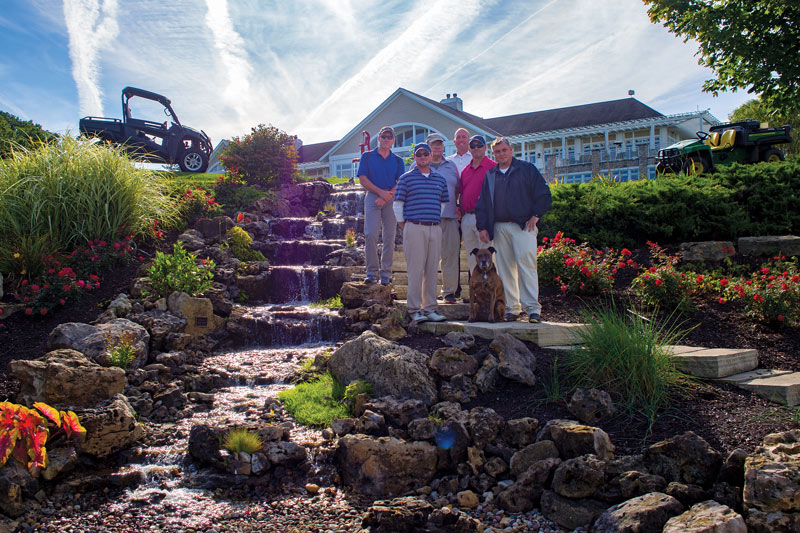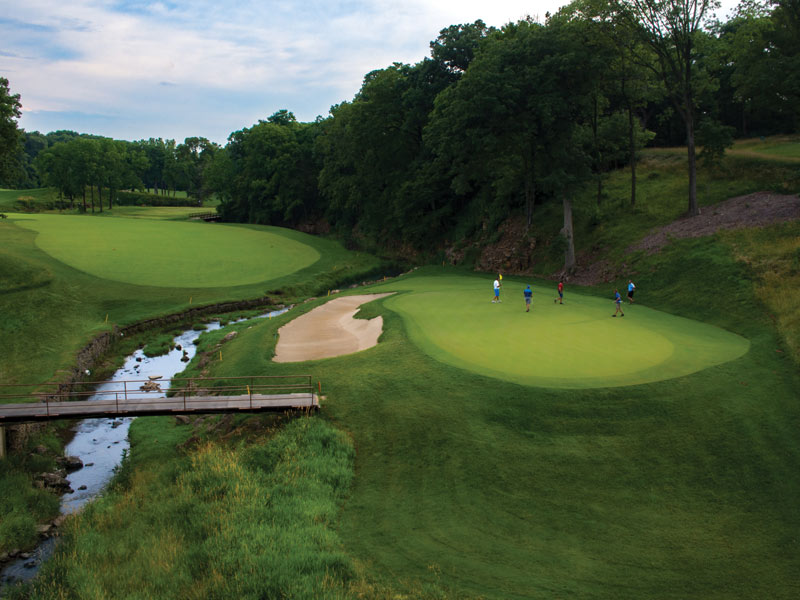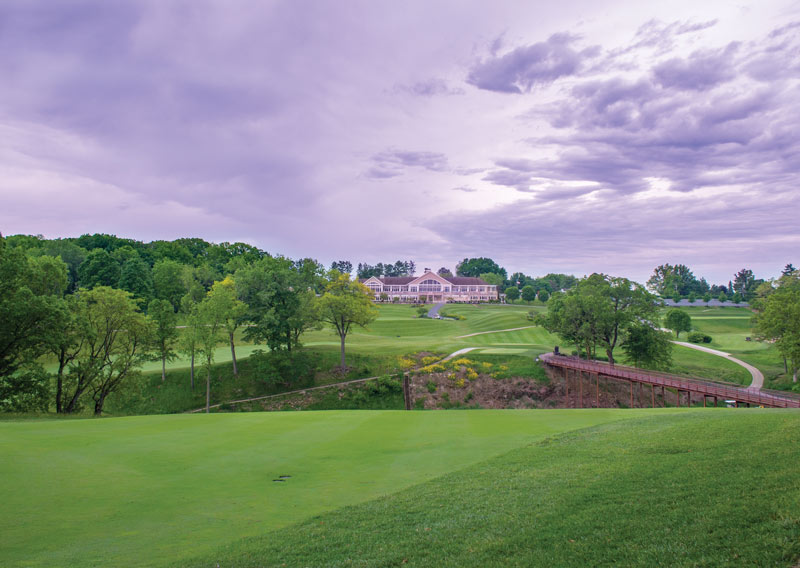
Dean Sparks (far right), director of agronomy at Davenport Country Club, led the way on the accelerated renovation of the 18-hole golf course in 2014. Pictured from left to right are Ted Allen, assistant superintendent; Dan Evans, assistant superintendent; Warren West, director of clubhouse facilities; John Panek, director of golf; Steve Brenner, equipment manager; and Bear, director of waterfowl management. Photos by Harry W. Walker III
Davenport Country Club is a private, member-owned club in Pleasant Valley, Iowa, which is part of the Quad Cities region in northwestern Illinois and southeastern Iowa. The golf course, opened in 1924, was designed by renowned golf course architects Henry Colt and Charles Hugh Alison, with Alison being the principal architect of the initial routing plan. The 18-hole layout makes dramatic use of the elevation and natural terrain, with two beautiful creeks coming into play on five holes. Davenport CC’s reputation grew quickly in its early years, and it was soon regarded as one of the top courses in the Midwest. In the 1930s, the famed 16th hole twice garnered national recognition when it was named an “All-American Golf Hole” by Sports Illustrated, and Golf Digest has consistently rated the course one of the best in Iowa.
Davenport Country Club (DCC) was a two-time host of the Western Open during an era when the event was considered a major golf tournament. The first of those was in 1936 and was won by Ralph Guldahl. During the second, in 1951, George Fazio shot a 63, breaking the course record of 64 held by Guldahl and Gene Sarazen. The ’51 contest was also when the 16th hole earned the nickname the “Hole of Grief,” after Sam Snead lost his chance to win when he hit his tee shot into a creek. The ensuing penalty allowed Marty Furgol to become the champion. The 1951 Western Open also holds the distinction of being the first golf event ever fully televised.
DCC had undergone several small-scale renovations over its 90-year history, but by 2014, the course would no longer accommodate modern equipment, and bunkers needed to be replaced, tees leveled, and pin locations increased on small greens. Formal discussions of a major renovation began in 2012.
I became the superintendent at DCC in March 2014, although my career had started at the club as a summer employee during high school. I’m originally from Bettendorf, Iowa, and the opportunity to come home as well as help bring DCC and the Quad Cities to national recognition through an improved, championship-feel golf course was a no-brainer for me. Throughout my 15 previous years in the superintendent profession, I’d completed major renovations for the TPC Network and at Pete Dye’s Crooked Stick Golf Club in Carmel, Ind. My experience encompassed everything from multimillion-dollar projects to smaller initiatives carried out in-house because of financial restraints.
The story of Davenport CC’s renovation touches on the challenges of tackling large-scale projects while striving to lose as little of the golf season as possible. This is how I planned for an almost complete renovation to happen in just a 50-day construction window beginning in July 2014, with a target opening date of May 1 the following year.
Reviving the past
In 2013, DCC selected the Forse Design team of Ron Forse and Jim Nagle to be the architects, given their vast experience with early-1900s golf course architecture. Returning DCC to its original design and playing features became the pair’s primary focus. To achieve this, greens needed to be expanded, tees repositioned and rebuilt to original locations, and fairway bunkers brought back into play. Several tees had, over time, moved to the left or right of the hole and created a different angle of play. Ron and Jim’s vision was for each golf hole to play similarly despite golfers’ different skill levels. All bunkers would be entirely rebuilt and given flat bottoms, and greenside bunkers would be repositioned with spectacular views of the putting surfaces through restoration of their original 3- to 5-foot faces. Fairways would be expanded, and the new selection of grasses — 007 creeping bentgrass and rhizomatous tall fescue (RTF) for roughs — would foster a firm and fast playing surface with challenging rough while eliminating the need for the frequent dollar spot fungicide applications that torment Midwest superintendents during summer. The project also called for the removal of hundreds of large trees throughout the 140-acre property, along with underbrush that had encroached on the playing corridors over the years. Both actions would help open up the course to its incredible natural views.
All hands on deck
For a seven-week period beginning July 28, 2014 — the day after the course was closed for the renovation — we had nearly 150 workers on-site daily, putting in 12- to 16-hour shifts.
DCC had selected Davey Tree to handle the tree removal, and we negotiated a plan to have the company’s seven best crews from throughout the Midwest at the club for six days to work like crazy. The crews arrived in the Quad Cities two days prior to the start of the project to ensure we could start promptly at 6 a.m. on July 28. The crew foremen were organized and prepared. DCC staff had identified the trees that needed to be taken out, and were able to lead Davey Tree crews right onto the course without regard for driving restrictions, as tree work was the first step in our fast-paced plan of action.
Davey Tree employees were instructed to simply cut as quickly as possible, and DCC staff would clean underbrush areas to a finish grade later, after snow had hit the ground in November. Wood chips from the extracted trees were used to help clean forest lines around the course, and large logs were either buried or donated to a sawmill museum for educational demonstrations. We needed the course to be clear of debris immediately to keep from slowing down the renovation crews.
Landscapes Unlimited had been chosen for the course construction based on the availability of workers, as well as on my past experience working with the company. Roberto San Juan and Dana Grode led our project, and all personnel again got into town before they were scheduled to be on the course. Roberto was on-site two weeks ahead of time to assist with the staging of materials and equipment. We’d created haul roads on the course about 45 days before the project commenced, so that semis could bring in products and dozers during July, while the course was still open for play. In total, 1,100 semis of supplies were delivered, all prior to the July 28 start date. (The look in members’ eyes as semis drove through the middle of the golf course was priceless!)

Channeling Charles: Enlarging greens was a component of DCC’s “retro rebuild,” aimed at reflecting the template Charles Hugh Alison came up with in the 1920s. Shown here is the renovated 18th green.
Renovations to greens, tees and bunkers were marked out with turf paint while tree work was happening so that we could also take advantage of those six days for rebuild prep. Bunker sand was removed and used for tee capping, greens mix was hauled to each site, and earth-working began on reconstructed holes. Gasoline and diesel fuel were delivered to two different holding sites daily, with two employees tasked solely with delivering fuel to equipment, which eliminated on-course traffic and downtime on construction work. DCC is in the heart of John Deere country, and seeing so much green equipment was amazing. In all, we had four dozers, 16 excavators, 14 tractors, six dump wagons and three full dump trucks, along with numerous Gator utility vehicles buzzing around every day.
Introducing improvements, keeping pace
DCC’s greens were scanned by Scott Pool of GreenScan 3D so that Landscapes Unlimited could restore the surfaces to their original design as closely as possible. We created new pin locations by basically stretching the greens, which gave us the opportunity to restore shape and contours by simply making the greens bigger. Greens went from 90,000 square feet to 130,000 square feet. We began seeding as we completed holes on the outer perimeter of the course, and we worked toward a common end point, which minimized traffic and kept everything moving efficiently. Seeding started Sept. 2 and wrapped up on Sept. 21, with the practice facility, nursery and haul roads seeded last.
Leibold Irrigation was our irrigation installation contractor. John Leibold has been a good friend of mine for a number of years, and I’ve always appreciated his commitment to my projects. His personal involvement, along with that of Jim Boyer, Leibold Irrigation senior operations manager, almost guarantees success. Leibold followed Landscapes throughout the course, changing green and tee loops, accommodating fairway expansions and installing additional 4-inch-pipe irrigation lines to help with looped pressure. A new pump station and building were installed, along with new controller boxes and a Lynx central control system. Tony Turner, Leibold project superintendent, executed the plan, and as you’ve likely come to expect by now, the pump station had been ordered weeks prior to the project, and building permits had been secured well in advance of our July start date.
After all seed was on the ground, we started the growing fertility program. (My approach here is aggressive and seems to align with the fact that my time frame for completing the project isn’t realistic in terms of actual needs, but that’s me.) We rolled everything two times prior to first cut. After first cut, everything was sprayed with 0.10 pound of nitrogen every four days until we’d achieved close to 90 percent coverage. Biweekly applications of potassium and magnesium were made to keep nitrogen-to-potassium ratios close. Chlorothalonil fungicide was applied at 10-day intervals, and Mefenoxam fungicide applications were made at 21-day intervals until nighttime temperatures stayed consistently in the 50s. Watering programs were four minutes at every station every 90 minutes to keep the ground wet without puddling.
November 2014 turned out a little chillier than normal, and we had a particularly cold winter in the Quad Cities that year, but all in all, our timetable ended up being pretty accurate. We opened the course on May 29, 2015, about four weeks shy of our intended date.
The home stretch
It has been three years since we kicked off DCC’s renovation, and we’re just getting to the point where the work is beginning to exceed everyone’s expectations. The majority of DCC’s membership was on board with the project no matter what, but there remained a few who didn’t see a reason for the changes (perhaps worried about future club finances or just resistant to change). However, most members now understand the architectural concepts introduced by Forse Design to restore the golf course to its intended look and feel, and the bigger greens, more pin locations and firmer, faster conditions have made it much more fun to play.

Heartland splendor: Davenport CC unfolds over 140 acres in the Quad Cities. Its current clubhouse was built in 2000.
An important facet of this project was communicating to the members that the first year post-renovation would be rough, as mechanical practices would be occurring on the course frequently. Getting members to understand that the process wouldn’t fully come to fruition until the third season was a focal point of our messaging. I did address the membership on two occasions before construction began, to answer questions in an open forum, but I expressed my desire to the club to have only a handful of members involved in the project after it got rolling. Once construction started, I met with a panel of five members every Tuesday morning to give them a status report. Autumn Keller, DCC’s general manager, and John Panek, our head golf professional, were instrumental throughout the project, handling everything from answering member questions at the clubhouse to helping arrange for hotel rooms for workers.
For me, thorough pre-construction prep — with an emphasis on advance staging of all materials — is the key to success with any sweeping renovation. These projects can become overwhelming when you’re in the thick of them, so taking time beforehand to eliminate as many distractions and potential hiccups as possible will prove worthwhile. The DCC maintenance team was awesome, and they really made the club their top priority during the renovation. (Well, other than the assistant whose wife had a baby during the week we were seeding greens. I jokingly told everyone that next time they all have to practice abstinence nine months before greens seeding.)
Good communication with all parties is vital throughout everything, given the large memberships and demanding personalities superintendents can come across at their facilities. Another important note is that most architects like to make several changes during the process, so superintendents need to be flexible and keep an open mind. Sticking to the plan as best as possible and personally knowing that the project is needed and is going to be a success — working through adversity and brushing off negative comments — will go a long way in getting you to the finish line.
Dean Sparks is the GCSAA Class A director of agronomy at Davenport Country Club in Pleasant Valley, Iowa, where he has worked since 2014. He is a 16-year member of the association.